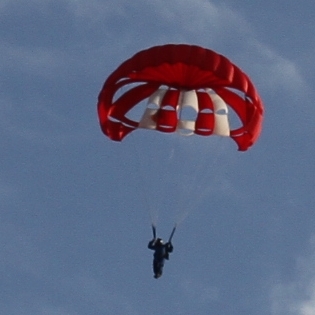Recommended Posts
councilman24 37
Years ago I asked Ted why he didn't change. I had a full stowage FREE SLEEVE PEP for awhile. Essential he didn't see the need to go to the expense of retesting his successful product line. I explain to pilots why I prefer full stowage systems and they still buy Strong rigs.
Terry Urban
D-8631
FAA DPRE
riggerrob 643
All the other Strong Para-Cushion PEPs - only stow the left line group in the diaper and - use the (pack tray) line stows as a kicker plate, to improve pilot chute launches.
Either that or Strong wants to drive young riggers to drink!
Tee!
Hee!
Even grumpy, old, grey-bearded me has to glance at the manual to remind myself where those complex line stows go.
QuoteEven grumpy, old, grey-bearded me has to glance at the manual to remind myself where those complex line stows go.
Now it's started.. How long before other manufacturers follow suit?
councilman24 37
From the National manual ... "The formal determination of “Time / Life” or service life of a non-military personnel parachute is still open ended and non specific. Someone must take the initiative and make a judgment call to ground it. By comparison: “Personnel (military) parachutes have a determined service life (a maximum shelf life) without use of 16.5 years, and every personnel parachute is stamped with a manufacturing date that starts its life-cycle clock. A personnel parachute is also stamped with the date that it is first placed in service (PIS). From that point on, a parachute’s service life cannot exceed 12 years. The longer the unit sits on the shelf the less service life it has once placed in service.”
The Parachute Industry Association (PIA) has visited this issue without conclusion to date. Until the PIA specifies or recommends otherwise, it is the opinion of the current management at National Parachute that the maximum service life is 20 years from date of manufacture"
Strong won't work on anything more than 20 years old but hasn't put it in writing for the rest of us.
RI has a 15 year life on the Aviator PEP, although not a drop dead date. A reinspection date.
From the Aviator manual ...
"With the use of modern first quality materials, Rigging Innovations, Inc. and Precision Aerodynamics, Inc. have established a 15-year service life from the component date of manufacture for the Aviator system. At that time the component must be returned to the manufacturer or its authorized representative for inspection and evaluation. Based on condition, a service life extension may be granted at that time."
Butler won't work on anything over 20 years old, in writing on their website, but leaves the service life for civilian use in the U.S. to the 180 day inspection.
From Butler's website but not really in a comprehensive manual... "When used in civil aircraft in the United States of America, under the rules and regulations of the Federal Aviation Administration BPPS personnel parachutes have an estimated service life of twenty years. However, parachutes must be inspected and repacked in accordance with the applicable service manuals and Federal Aviation Regulations, every 180 days. If more than 180 days has passed since the last inspection and repack, the parachute is considered unairworthy until such inspection is accomplished."
So, most of the pilot rigs are there or close. Softie wasn't the first.
Skydiving rigs? Who's brave enough to be the first? Outside of tandem.
Terry Urban
D-8631
FAA DPRE
riggerrob 643
QuoteQuoteEven grumpy, old, grey-bearded me has to glance at the manual to remind myself where those complex line stows go.
Me too..
Now it's started.. How long before other manufacturers follow suit?
..........................................................................
A long time ago.
Other manufacturers started setting "lives" for components a long time ago.
For example, GQ Defence (British successor to the American company GQ Security) set a life of 15 years, depending upon a "critical inspection" after ten years, which means that all of the 150, 250 and 350 Safety Chutes built in the USA are obsolete.
Hint: GQ Security closed its factory doors (in San Leandro, California) in 1984.
fcajump 164
Does a rig considered legal for use by Mil. Spec (rather than TSO) expire from legal civilian use once the military life expires? I know several pilots that use old military rigs.
Or, similarly the jumpers using modified NB-8's to jump vitage gear?
JW
JerryBaumchen 1,422
Hi Jim,
Interesting question.
I do not work for the FAA and therefore cannot speak for them. I do not think that any of the 'normal' posters here do/can either, IMO.
I haven't looked at the wording in eons but I 'think' that it did not make any mention of age.
IMO, you can use the surplus military stuff forever, as long as a rigger considers it airworthy.
Since these thoughts did not cost you anything, consider their value. ![]()
JerryBaumchen
Quote
I haven't looked at the wording in eons but I 'think' that it did not make any mention of age.
IMO, you can use the surplus military stuff forever, as long as a rigger considers it airworthy.
Jerry,
I do not know how "normal" I am, but have something to add!
I asked this question about 10 years ago and found a few answers.
1. Military service life is "in" the military only
2. This why the military usually "decommissions" the gear either by cutting the leg straps or lines after military service life.
AFAIK, Contract gear has no civilian life limits.
Cheers,
MEL
www.Skyworksparachuteservice.com
councilman24 37
Might depend on the wording of the mil-spec design for the contract and I've never seen one, hmm that I remember. If it specs a service life then it might be hard not to follow it. IF the service life is imposed on the item outside the contract and mil-spec by the purchasing agency then may not apply.
Certainly the FAR's only talk about military designation. Part 105
"Approved parachute means a parachute manufactured under a type certificate or a Technical Standard Order (C-23 series), or a personnel-carrying U.S. military parachute (other than a high altitude, high speed, or ejection type) identified by a Navy Air Facility, an Army Air Field, and Air Force-Navy drawing number, an Army Air Field order number, or any other military designation or specification number."
NOTE U.S. military only allowed. No British, Chinese. Hmm, I think the old Israli MA-1 were U.S. military spec with a Israli manufacturer and okay. I'll have to look at the one in my kids toy box.
And part 65 "
(e) Pack, maintain, or alter a parachute in any manner that deviates from procedures approved by the Administrator or the manufacturer of the parachute; "
If you try hard you could probably get back to a military manual that specs the life limit, maybe.
But I don't know what the hell I'm talking about.![]()
Terry Urban
D-8631
FAA DPRE
Quote
you try hard you could probably get back to a military manual that specs the life limit, maybe
I asked about that also; they(US Military) are not the manufacturer, just the owner in the FAA's eyes.
The blub about following manufacturer's instructions would be moot here.
BS,
MEL
www.Skyworksparachuteservice.com
riggerrob 643
QuoteQuote
you try hard you could probably get back to a military manual that specs the life limit, maybe
I asked about that also; they(US Military) are not the manufacturer, just the owner in the FAA's eyes.
The blurb about following manufacturer's instructions would be moot here.
BS,
MEL
..............................................................................................
Military manuals become a grey area, but - generally - civilian riggers are expected to follow military manuals when packing military-surplus parachutes.
For example, the last time I was asked to repack a military-surplus parachute including an obscure AAD (made by FXC), I phoned FXC to ask for a manual. FXC replied: "Don't waste your time asking us, because the only manual for that equipment is a United States Air Force manual." Fortunately, I was able to get a photo-copy of the USAF manual from a rigger who worked at Edwards AFB.
Most of this debate about military-surplus maintenance schedules is academic because the US and Canadian military started cutting lines off of military-surplus parachutes crca 1980, so civilian riggers will rarely be asked to repack any military-surplus parachutes less than 30 years old.
Hint: the Canadian Army puts a 25 year "shelf life" on most of its parachutes. After that, lines are cut off and they are sold for scrap.
fcajump 164
QuoteQuote***
Most of this debate about military-surplus maintenance schedules is academic because the US and Canadian military started cutting lines off of military-surplus parachutes crca 1980, so civilian riggers will rarely be asked to repack any military-surplus parachutes less than 30 years old.
True, but it does happen. I know of several people still sitting on 1950's seat PEPs (I don't pack them myself) and I have seen some mil spec rigs for sale intact that are newer than 1990. Its also not hard, in the case of a canopy, to reline. The question is, when brought such a system, what next...
Thanks for all the input!!JW
Always remember that some clouds are harder than others...
riggerrob 643
As far as I know, the only (and they are really, really rare) airworthy US military parachutes sold in the 1990s "snuck out the back door of a warehouse" or were bought from a third world air force that bought second-hand USAF airplanes. If those are still in good shape, I repack them in accordance with the manual.
Re-lining a round canopy?
Hah!
By the time you replace the continuous lines on a C-9, it is more (expensive Master Rigger) labour than building a new canopy!
RiggerLee 61
Lee
lee@velocitysportswear.com
www.velocitysportswear.com
fcajump 164
JW
What I am asking is;
Can those rigs be inspected by the factory and a longer life granted?
I tried downloading that manual but my internet connection is really slow right now so it would not complete the download.
We have one that was built in December 93 so it still has a couple of years left, but it is like new, it was in a coset in a carry bag for 15 years.
There would be 10 year old rigs in much worse condition.
councilman24 37
Is it part of the manufacturer's instructions that we must follow? I think so. My inspector thinks so. The manufacturer thinks so. And so does their inspector. The manufacturer won't tell you it's illegal. They'll point to their manual and the regs and say they have no power to stop you from packing it. But, they will say it violates their manual. Probably in a court of law or to an inspector.
You get to decide what your interpretation of the law is. And ask your inspector what their's is.
Terry Urban
D-8631
FAA DPRE
mark 107
Mark




.........................................................................
The question is whether older parachutes have the same CONFIGURATION as the new manual.
Since Javelin reserve pilot chutes have not changed in the last twenty years, I recently started using the new method to pack all Javelins. It results in a prettier pack job, with less fabric sneaking out.
Share this post
Link to post
Share on other sites